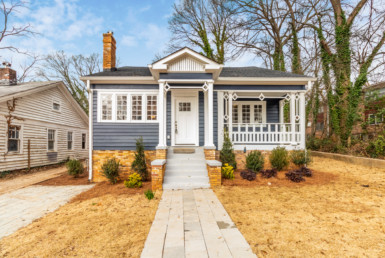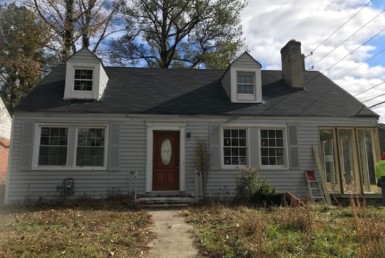An Uptown couple converts two former shipping containers into an eco-friendly modern home
SOURCE: NOLA.com
By on March 11, 2015 at 10:59 AM, updated March 11, 2015 at 11:43 AM
Steel shipping containers are used to crate cargo up and down the Mississippi River and around the world. The Port of New Orleans is filled with the massive steel boxes.
Three years ago, one young Uptown couple bought two of the freight containers and turned them into a modern, efficient and eco-friendly home.
“This was a crazy idea that somehow managed to be,” said Seth Rodewald-Bates, who built his Carrollton-area house out of two 4-ton used shipping containers purchased from Boasso America and pulled off the New Orleans Terminal in Chalmette.
Bridged by a traditional wood frame, the container house includes a small bedroom, a small bathroom, kitchen, living area and office.
The home’s open layout is roomy enough for a sofa, five chairs, a kitchen island, two bicycles, a standing fan, bookshelves for 400 books and a 10-foot desk — all in 720 square feet.
“That’s not an uncommon dimension in New Orleans,” Rodewald-Bates said. “If you’ve lived in a shotgun, the halls are narrow,” he said, striding through his home’s hall from kitchen to bedroom. “Day-to-day wise, you don’t realize it’s a container.”
Container architecture is an environmentally friendly design trend that re-uses steel intermodal containers as a structural building element. The low expense and wide availability of shipping containers — as well as their sturdy, rectangular shape and weather resistance — make them easy and efficient to use for home construction.
A quick Google search produces scores of websites and articles on recycled freight containers turned into guest houses, small vacation cabins, luxury homes, schools, restaurants and skyscrapers, even student housing.
A landscape architect from Texas, Rodewald-Bates first learned about upcycling shipping containers more than a dozen years ago as a graduate student in the LSU School of Architecture.
Then in 2011, he and his wife, Elisabeth Davies, had the good fortune to snap up a long, narrow lot in the West Carrollton area for $5,000. The modular homes he studied at LSU sprang to mind.
“We wanted to deliberately have a small footprint,” Rodewald-Bates said. “I had always wanted to do it, and I was like, ‘Here’s a nice skinny little lot, and I can do it.'”
From the street, the shipping container stands out in the architecture. Primed in Rust-Oleum orange-brown, it still sports white stenciled numbers once used to identify cargo.
Original steel doors now open out to reveal windows. Functioning as large shutters, the heavy-handled doors provide both safety and sun protection.
Let in the light
Inside, the small, narrow house is surprisingly airy and cheerful.
Rodewald-Bates and Davies knew from the outset that they wanted to bring in warmth and light, the couple said. They built their addition using wood slats, steel cables and an acrylic called polygal — essentially a large plastic sheet that, in this case, has a rippled effect and looks like translucent glass. They raised interior ceilings to 14 feet.
Now, at night the home looks like “a glowing box” from the street, Rodewald-Bates said. By day, it receives abundant light.
To keep things light, the couple installed floors and built furniture from Southern pine from Marfa, Texas, the desert town where they met. They painted the home’s interior walls and all wood framework white and are still considering whether to pickle the floors.
“Just because it’s small doesn’t mean you have to skimp on materials,” said Rodewald-Bates, who used Carrera marble and hexagonal floor tile in the bathroom and created a modern kitchen using granite and stainless steel.
He filled the front yard with permeable gravel for storm-water management and eventually hopes to have a vegetable garden and raise chickens. Ultimately, his backyard will be landscaped to resemble a tropical jungle.
“People’s reactions surprise me. So many people say it’s beautiful,” Davies said. “That surprises me. It’s not the word I would have chosen.”
She grew up in Brooklyn, where real estate costs are often prohibitive.
“It’s been an adventure. I never thought I would be able to build a house,” she said. “It’s really cool.”
Handled with care
When the couple purchased the 25-foot-by-125-foot lot, they were renting a home from Byron Mouton, a Tulane University architecture professor.
Rodewald-Bates talked to Mouton about his ideas and came up with three proposals. The simplest was for a basic, 350-square-foot home, while the most extravagant called for a two-story house built with three containers. The middle plan — which they built — was most cost-effective.
Mouton’s architectural firm, Bild Design, helped complete designs and set the concrete foundation, raised 3 1/2 feet from the sidewalk to protect against flooding.
It’s not easy to pull a crane through small residential streets and swing 8,000-pound steel containers into perfect position, the owners said.
That tackled, Rodewald-Bates and a team of handy family and friends spent weekends and nights over the next two years building his dream. They installed air conditioning, heating and four doors leading outside. They ran plumbing and electricity. They built a 4-foot loft above the kitchen to allow for storage.
Davies, an assistant pastry chef with the Donald Link Restaurant Group, got a fancy five-burner stove.
Rodewald-Bates, an associate with Spackman Mossop Michaels landscape architecture and urban design firm, got a small, raised gunite plunge pool with a white plaster finish.
Upsides and downsides
Finding financing was difficult, said Rodewald-Bates, who could not initially convince local lenders of the merits of shipping container homes.
“Financially, they’re going to remain accessible only to people that can find or have the money to privately fund container-based projects,” he said.
At this point, he and Davies have invested about $200,000, all told.
“Keep in mind that includes a good deal of free labor,” he said. “The containers themselves are relatively inexpensive; they were each about $4,750 plus delivery.”
His home probably cost more per square foot than conventional construction, Rodewald-Bates said.
“There were moments we were skeptical. It definitely lives larger than it is,” he said, noting that shipping containers are long and narrow — “not really human-scaled. … Contemporary space with contemporary consumption, they don’t go together very well, so you have to embrace it.”
But Rodewald-Bates, who looks at shipping containers as another construction material, like wood or brick, is a fan.
“From a conservation standpoint, the idea that you’re up-cycling containers is an advantage in my mind,” he said, pointing out that more than 500 million tons of cargo runs through the Lower Mississippi River annually.
After their shipping days are over, thousands of used frieght crates are put for sale on eBay and other sites.
“They are relatively inexpensive and modular,” Rodewald-Bates said. “They are incredibly flexible — in the sense that with a welder and a cutting torch you can make almost any modifications you want.”
SOURCE: http://www.nola.com/homegarden/index.ssf/2015/03/an_uptown_couple_converts_a_fo.html




Join The Discussion
You must be logged in to post a comment.